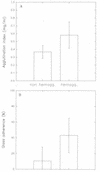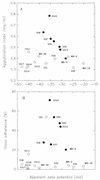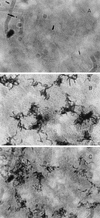Surface properties of bifidobacterial strains of human origin
- PMID: 9435057
- PMCID: PMC124666
- DOI: 10.1128/AEM.64.1.21-26.1998
Surface properties of bifidobacterial strains of human origin
Abstract
The adherence of Bifidobacterium strains isolated from infant feces and commercial fermented dairy products to enterocyte-like cells was correlated with the autoagglutination and hemagglutination properties of these organisms. These results allowed us to define two groups: (i) cell-adherent bacteria showing hemagglutination and autoagglutination and (ii) non-cell-adherent, nonhemagglutinating, nonautoagglutinating bacteria. Glass adherence was shown to be nonspecific and was discarded as a criterion for selection of adherent cells. Hydrophobicity appeared to be necessary for adhesion to enterocyte-like cells and autoagglutination. Adhesive strains were highly hydrophobic, and the degree of adherence was slightly dependent on the surface potential. Cells autoagglutinated more when the electrostatic negative charges on the cell surface were shielded by a decrease in the pH from 7 to 2. However, in some strains negative charges at the cell surface were adjuvant to adhesion, thus suggesting that specific chemical interactions occurred. The present results provide a method for preliminary selection of bacteria potentially adherent to epithelial cells by means of autoagglutination.
Figures





Similar articles
-
The correlation between surface hydrophobicity and adherence of Bifidobacterium strains from centenarians' faeces.Anaerobe. 2006 Jun;12(3):148-52. doi: 10.1016/j.anaerobe.2006.03.001. Epub 2006 May 3. Anaerobe. 2006. PMID: 16765861
-
Real-time PCR quantification of bacterial adhesion to Caco-2 cells: competition between bifidobacteria and enteropathogens.Res Microbiol. 2005 Sep;156(8):887-95. doi: 10.1016/j.resmic.2005.04.006. Epub 2005 Jun 9. Res Microbiol. 2005. PMID: 16024231
-
Effect of bile components on the surface properties of bifidobacteria.J Dairy Res. 2002 May;69(2):293-302. doi: 10.1017/s0022029901005313. J Dairy Res. 2002. PMID: 12222806
-
Adhesion of human bifidobacterial strains to cultured human intestinal epithelial cells and inhibition of enteropathogen-cell interactions.Appl Environ Microbiol. 1993 Dec;59(12):4121-8. doi: 10.1128/aem.59.12.4121-4128.1993. Appl Environ Microbiol. 1993. PMID: 8285709 Free PMC article.
-
Adhesion, autoaggregation and hydrophobicity of 13 strains of Bifidobacterium longum.Lett Appl Microbiol. 2000 Dec;31(6):438-42. doi: 10.1046/j.1365-2672.2000.00845.x. Lett Appl Microbiol. 2000. PMID: 11123552
Cited by
-
Bifidobacteria isolated from infants and cultured on human milk oligosaccharides affect intestinal epithelial function.J Pediatr Gastroenterol Nutr. 2012 Sep;55(3):321-7. doi: 10.1097/MPG.0b013e31824fb899. J Pediatr Gastroenterol Nutr. 2012. PMID: 22383026 Free PMC article.
-
Comparative genomics and functional analysis of a highly adhesive dairy Lactobacillus paracasei subsp. paracasei IBB3423 strain.Appl Microbiol Biotechnol. 2019 Sep;103(18):7617-7634. doi: 10.1007/s00253-019-10010-1. Epub 2019 Jul 29. Appl Microbiol Biotechnol. 2019. PMID: 31359102 Free PMC article.
-
Review on Bifidobacterium bifidum BGN4: Functionality and Nutraceutical Applications as a Probiotic Microorganism.Int J Mol Sci. 2016 Sep 14;17(9):1544. doi: 10.3390/ijms17091544. Int J Mol Sci. 2016. PMID: 27649150 Free PMC article. Review.
-
Genomic diversity and relatedness of bifidobacteria isolated from a porcine cecum.J Bacteriol. 2003 Apr;185(8):2571-81. doi: 10.1128/JB.185.8.2571-2581.2003. J Bacteriol. 2003. PMID: 12670982 Free PMC article.
-
Adhesion mechanisms of Bifidobacterium animalis subsp. lactis JCM 10602 to dietary fiber.Biosci Microbiota Food Health. 2021;40(1):59-64. doi: 10.12938/bmfh.2020-003. Epub 2020 Oct 3. Biosci Microbiota Food Health. 2021. PMID: 33520570 Free PMC article.
References
-
- Busscher H J, Geertsema G I, van der Mei H C. On mechanisms of oral microbial adhesion. J Appl Bacteriol Symp Suppl. 1993;74:136S–146S. - PubMed
-
- Crow V L, Gopal P K, Wicken A J. Cell surface differences of lactococcal strains. Int Dairy J. 1995;5:45–68.
-
- Fontaine I F, Aissi E A, Bouquelet S J L. In vitro binding of Bifidobacterium bifidum DSM 20082 to mucosal glycoproteins and hemagglutinating activity. Curr Microbiol. 1994;28:325–330.
-
- Geertsema-Doornbusch G I, van der Mei H C, Busscher H J. Microbial cell surface hydrophobicity. The involvement of electrostatic interactions in microbial adhesion to hydrocarbons (MATH) J Microbiol Methods. 1993;18:61–68.
Publication types
MeSH terms
Substances
LinkOut - more resources
Full Text Sources
Other Literature Sources

